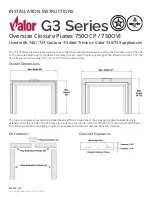
21
21
Location
Venting
Vent Material
This unit is approved for installation using 4 x 6-5/8
inches approved co-axial direct vent pipes and acces-
sories listed on pages 43–44 of this guide. Follow the
installation instructions supplied with the individual
venting accessories.
This unit may also be converted to co-linear vent-
ing with two 3-inch pipes for use in solid-fuel burning
replaces and chimneys using approved adapters and
accessories listed on pages 43–44 of this guide.
Wall Thickness
The appliance vent is suitable for penetrating a com-
bustible wall assembly up to 14 inches in thickness. A
non-combustible wall can be of any thickness up to the
maximum horizontal run of vent pipe allowed for the
particular installation.
Vent Sealing
Seal all outer coaxial pipe and
elbow joints, including sectioned
elbow joints, using high quality,
high temperature 2 inch wide
self-adhesive aluminum foil tape
(Nashua-322-2 brand or simi-
lar). Wrap the tape completely
around all joints and press
rmly
to seal.
A high temperature black silicone sealant may be
used in the outer joints as a substitute to foil tape.
Ensure all the pipe joints have a minimum of
1 ¼ inch overlap.
10” (254 mm)
10” (254 mm)
Align the vent
center to the
center of the
frame
Square opening
Vent Penetration through Walls & Ceilings
Combustible:
When penetrating through combustible
walls and ceilings, frame a minimum of 10 inch x 10
inch opening and ensure that the insulation is kept
clear of the vent pipe using either a wall thimble
or an attic insulation shield. Follow the installation
instructions supplied with the individual venting
components.
Non-combustible:
If the wall is totally non-combustible
(e.g. masonry block or concrete), mark for a 7 inch
circular hole.
In both cases, the center of the hole should line up with
the center line of the horizontal vent.
Tape all joints
(including all
elbow joints)
All horizontal pipe runs must be graded 1/4 inch per
foot upwards in the direction of the exhaust
ow. The
nal pipe length, when terminating through the wall
may be graded downwards slightly to prevent water
migration.
QUALIFIED
INSTALLER
















































